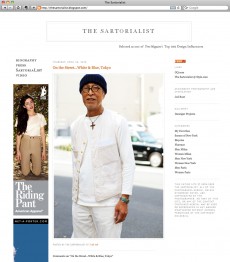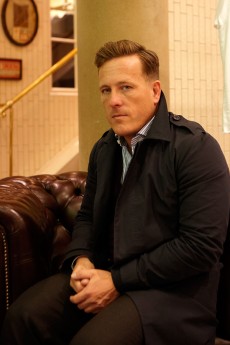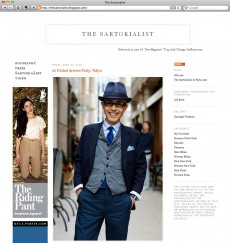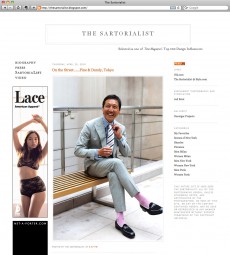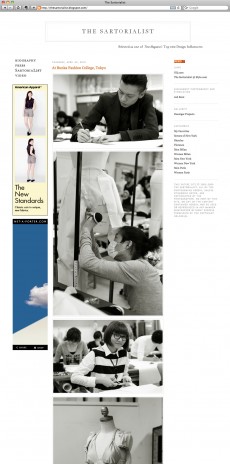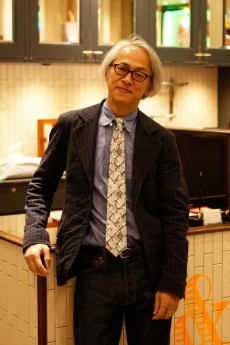
Scott Schuman, the owner of a much-loved fashion and photo blog The Sartorialist from New York, finally visited Japan for the first time to celebrate the renewal opening of United Arrows Harajuku Flagship Store Men’s Building and join its reception party.
We have been a big fan of The Sartorialist. This time, we had an opportunity to see Scott and talked about topics ranging from his view of the new United Arrows to the impression he received from Harajuku.
Making the meeting even more special, we had Hirofumi Kurino, Senior Adviser of United Arrows with us. Hirofumi is such a well known guy among fashionistas and doesn’t need us to explain who he is, isn’t he?
So here it is. This is a one of a kind interview. We hope you will enjoy it!
Text: Tomoyuki Ishikawa
— This is your first time in Japan and how is Japan, like the town and everything?
Schuman: It’s very over whelming. You know the hard part of doing a blog is it’s so daily. Write every day, I’m taking pictures and putting pictures up. The first day I put pictures up, I took some pictures around here and someone left a comment, “Well you obviously don’t understand Japan. These are not pictures of us doing our best.” And I wanna say I’ve only been here for one day and it is very complicated, there are so many different types of style and it’s so overwhelming and it’s so big. How can you possible understand it in one day? I think it’s fascinating. Now I just have to figure out how to keep coming back. It’s like something like anywhere else I’ve been. And that’s good things and bad things about that.
— Is there anything funny you found in Japan? Like Pocari Sweat (Note: Japanese famous drink) you mentioned in your blog, for example.
Schuman: Um… funny… well see, I mean that the Pocari Sweat thing, when I did that, it was it was totally a joke right, but many people didn’t understand the joke especially Europeans. I’m saying “Is it really made from real sweat or artificial sweat.” I mean it’s obvious that it’s a joke. But a lot of Europeans were like “Oh you know how can you as an American can talk about other people’s whatever.” So one thing you learn is that you have to be very careful about how you joke
around. But um, anything funny… No, I just think its different. It’s just different. It’s fascinating here because the cultural references are so different from American cultural references, the concept of beauty is so different from American or European concept of beauty in just little things, you know. I was mentioning at last night dinner that a lot of girls here wear high heels, and very very short skirts.
And yet somehow in some place like in Italy, if they wear such short skirts and high heels, it would look very sexy. Somehow here they are able to do it to look cute. I don’t know what it is. For some reason they juts look cute than sexy. Although the girls are pretty and everything. Those things, its not really funny, its things you….you are trying to understand it. My pictures hopefully come out nicely, hopefully there is a sincerity because I’m really trying to understand it. I’m curious about them and I’m trying to understand what those differences are. That’s why I go to so many different places. So I can create compare and contrast between like Tokyo and Berlin. It’s a long answer I’m sorry.
— What is the image you have for the people walking around in this area, fashion wise?
Schuman: I think there is a difference between perception of what Japanese street style is and what the reality is. There’s a difference between those. And I think the reason there is a difference is in the west, is because really the only pictures we see are bit crazy Harajuku, right.
And that’s usually because you know someone like me takes pictures here, I think it’s usually young person that is drawn crazy crazy and so that’s really the only pictures we see, whereas when I come here I would like to shoot more wide range, different kinds of people. So yesterday, I put a picture up of a gentleman with a blue cap and white… I didn’t realize he worked here, I didn’t know he worked here.
I shot just over here but I didn’t know him, you know, I just asked to take his picture, but I mean he’s part of harajuku, too but you never see pictures of these guys, and I think that is the reason my blog has separated itself from a lot of the other kind of blogs. I don’t always wanna shoot crazy, you know. I shoot a little bit of that, but I’m a regular guy and I’ve got a regular girlfriend, and I want shoot things that I relate to also so I think that helps widen the perception of what real Japanese style is. Its much more complex, much more diverse, than what we are in the west usually know.
— By the way, you said little while ago that Japanese dress very well but don’t take too much care of hair…
Schuman: No, its not that I said don’t take too much care. I think they take a lot of care with their hair, its just not for me it doesn’t look great. For some of certain section group, their hair is big, crazy hair and stuff but that’s just my own life and my own taste and that’s why I say the cultural idea of beauty is so different. I can’t make it right or wrong. To me it doesn’t appeal but I don’t live that lifestyle. But it doesn’t appeal to me so it makes harder for me take a photograph. I might like the clothes but I you know. It’s trickier.
But I mean that’s a trend and the trend will change. I’m sure when I come back a year from now the hair will be totally different. The other point I want to make is that the concept of Japanese street style, you know a lot of people say on my blog "Oh japanese street style is great, anything goes and so unique, they do whatever they want they do so many things.” But after walking around here, I just don’t think that true. I think here in Japan they are totally open to any kind of reference, you know. The trend can be any kind of reference, western, astronaut, whatever. Sports. The references are totally open maybe more so that you have in the west or America. They are open to any kind of reference but once it’s agreed upon trend, everybody wears it. There is some individuality, but I also think its very very trend driven here. For example, a lot of the girls here wear those straw border hats, right? And if I see that once, I see that twenty times a day. So I think there is a real variety in kinds of styles, but once its been accepted, wow boom, you know. But because there are no girls in the west wearing straw border hats and stuff, it seems very different, it seems very individual. But its just it’s a trend here but not really anywhere else. The trend here is very unique to here.
— Basement floor, how did you think about it?
Schuman: Oh great, very cool. You know I’ve wanted to come to Japan for a long time and I have a lot of offers, I really cant tell from who though.
It was the right offer with right people, to come and see Japan and really have the right people to help me understand Japan. So Mr. Kurino came up with this idea, it was perfect. And when I first started shooting, I didn’t know who you are, I didn’t know who Poggy was, I was shooting these guys individually but I didn’t realize. It wasn’t until later I realize all these different guys I’ve been shooting all worked for the same company. Because the conversation is so difficult, you speak English very well but Poggy he speaks little. And usually interaction is very short. So it just seemed so natural to come here with United Arrows. And someone like Poggy, he really has a very unique style and I really really like it. I mean its not like he looks like a movie star, its not like he’s a handsome guy, he is a handsome guy but its not like a movie star, but I think he looks so cool, and that’s what I respect.
Kurino: Very original.
Schuman: Very original. And what I respect is someone who can translate their style to bigger format. It’s very similar to Carine Roitfeld of Paris Vogue. That magazine looks like her. You know kareen really puts her heart to the magazine. And it gets the same thing at the shop down stairs, you know. You walk around the space and you know it’s him. You know its not like this is done for commercial, lets come up with a new space, we’re gonna have this designer. In America this is what’s happening often. They come up with a space and they try to get all designers in the space.
Kurino: Just for the trend.
Schuman: And for the name to sell the label. Here, I think there are designer names, but you feel his eye, his presence in there because everything seems like him. I used to have a show room and used to deal with stores for 15 years so I’m very very sensitive to shops and shopping experience and things like that. So when I go down there I thought “Wow this is really well done.” Because whether you like his style or not, it’s a real point of view and so many stores around the country are afraid to have a point of view. They are afraid of missing sales as opposed to being going and getting them, making people their ??? (unable to dictate).
— How did you think about the interior used in the store?
Schuman: I loved it. One section with the DJ booth, it reminded of me my older brother, what his room looked like when I was growing up, music and all these kind of stuff you know. I think it seems like kind of a place you wanna go, you wanna be a part of that life style, its aspirational. You go in and think “Wooo cooool!” You know it’s a place like Collette. There are certain stores that you go in and “Wow I wanna live this lifestyle.” So part of the greatness is its potential of expanding and adding his take on magazines and his take on books or whatever, I think the hardest thing to be able to do is to communicate your vision to other people and make them want that.
— Two days ago we had a reception downstairs. When you saw all these people working in the fashion industry, how did you think of those people?
Schuman: Very cool. I was only sad that it was so dark and I couldn’t take pictures. But like anywhere people are good, doing really really good, and other people they do a nice job. In any city what I’m always looking for is that small percentage of people just have some kind of magic about them, you know. Those I like to take pictures of. Cuz it’s not really about what label it is. It’s just something about looking at the picture and it’s inspiring. And it just happens to be a high
percentage of those people here. You know there were a lot of those people at the party the other night. I mean there a lot of people nicely dressed. For example, like the guy who is making ties…
Kurino: Oh yes, President Keii of FAIRFAX.
Schuman: You know, I took a picture of him, and I mean he comes right through the camera. You look at the picture and you cant look away, you think “Wow that guys just so cool.” It’s not that you wanna look like him, but you wanna be like him a little bit, like you wanna have a picture of him. Did you see the picture? Great smile, so much charisma, that’s why I do what I do. Because its now like when you look at the picture I don’t wanna dress like him, but I think it’s the swagger he has, this guy is so comfortable with himself, you know. He’s not the tallest guy, he’s not the youngest guy, he’s not most beautiful but he’s got such a charisma. Luckily there was quite a few guys or few girls you see at the party. And what always fun for me is trying to see these people and capture that and share that with the rest of the world.
Kurino: You saw highly percentage than the other country.
Schuman: Oh yeah. If you go to somewhere like Berlin, its just a smaller percentage of people that dress in a certain way, dress in a way that is attractive to me anyway. Here, I don’t know if its cultural thing or what it is but you see like in stores here I think Japanese design…
I don’t know if its design, its style, cuz Japanese design like Yohji, that’s a little bit different from what you see in the stores.
Japanese style, modern style plays on all the elements of design.
Color pattern, texture, proportion, detail so at a party like the other night, you saw so many different variations of great style.
Whether it is a style I would wear or not, it’s one of the reasons I’m taking pictures because I wanna try remember. What was that the guy was wearing dots, stripe, plaid this and that, and there just much higher percentage here. Like if you go to Berlin, everybody wears black, same shoes and it’s just less exciting. Because there is not much variety. It’s more safe there.
Kurino: Tokyo has more variety.
Schuman: Yeah.
Kurino: Now they want me to ask you. I know you for these three four years.
When did you start your blog?
Schuman: In 2005.
Kurino: So five years ago.
Schuman: Almost five years ago.
Kurino: What was the reason?
Schuman: Um, you know id look through the magazine, right, like American GQ.
You know pictures were nice but after a while it’s all just big advertisers. And it starts to become little bit of a formula. I love GQ, I love fashion magazines but I would see a lot of guys in the streets, they weren’t dressed like in magazine but still cool.
American GQ, they cater to American taste. But there are all these cool Italian guys in New York and they would just dress differently.
But you never saw that reflected to the magazine. And I’d be like, I’d think of a guy I’ve seen on street and what was it he was doing? Like if I wanna do my pants in a certain way, you know how much break was it, where did the pants hit, so literally its kind of a reference myself like how I wanted to dress. So it was very personal. But, at the same time, I wanted to take a picture I want to look at, I didn’t just want reports on clothes, like he’s wearing those shoes. I wanted to capture in the romantic way that I saw it. So I wanted to take nice pictures, pictures I would want to look at. So it’s the mix, again why mine is little bit different is, you know I do love the fashion, but there that hopefully in a good picture, little bit of swag or little bit of something its beautiful about it so you actually wanna look at the picture. And then see what they are wearing. On so many other street style sites, they just have a person stand up against the wall and they are just telling you what the person is wearing.
Kurino: Whose Jacket, whose pants…
Schuman: Exactly. And there’s very little personality of the person. Where, you know, I took a picture of Mr. Kashimida? Is that right?
Kurino: Kamoshida? (Note: Yasuto Kamoshida, Creatice Director of United Arrows)
Schuman: Right, he was sitting all nice and everything, then you know you kind of look down there and he has good smile and you know that was the picture. Because I could’ve taken a picture just standing and report what he was wearing, but you know it was the picture of him, he’s got great smile, he’s got such great personality that makes you wanna know that person little bit, and look little more closely at the picture because it’s not just about the shoes. If the picture is more boring, you would just look at the shoes, but I’ve tried to capture all his personality and "Oh wow okay, the guy looks kinda cool and he’s
wearing cool shoes.” The concepts are easy.
Kurino: So very naturally you started.
Schuman: When I started, there were no blogs making money, there were no big important blogs, so it was very much from the heart. Because now there are people like me, it’s proven you can do something influential, can go and sit in the front of fashion show, you can make money, you can make a living doing this. But when I started there wasn’t that. But I think the reason mine is different is there is more heart, because I really did and I still to this day, still do it the way I feel comfortable doing, and it’s the honesty and integrity that I think separates what I do because I’m doing it for the right reason, from I think anyway.
Kurino: Like you said, not for brand, not for commercial, not for advertisement, not for making money but for your own personal reason, own curiosity, more human based. That’s why I like your work, that is why my idea is to invite you here. Because yourself, Kamoshida, myself and Poggy, have a same spirit.
Schuman: Yeah, that’s why its very good, natural kind of collaboration to come here because you kind of trusted it the right people to go and do that with. I knew I would come here eventually. I get offers to go all over the world. I go to Australia after this, and I’m going to bunch of other places. So I can wait until it feels right. And yesterday I put pictures up from Bunka and that has nothing to do with.. It has a spirit of fashion but I didn’t write what they were wearing, it’s the spirit of creativity of seeing these young kids working the romance of, so if I keep focusing on what I think romantic, like I went to school like that so I know what its like to sit in those rooms and all that, so that’s why I can shoot that way. That little section is as important as shooting manual arts of some fashion.
Kurino: That’s why you put that in monochrome. Very romantic way.
Schuman: Yeah romantic way and also because of the light and the space makes everything too yellow, so make it in black and white, makes the skin tones better. And yeah its little romantic. What they are really doing what was important was the idea… I mean how many of us get to do a job we get to do something creative, and it gets why people love the idea of fashion college so much, cuz it seems you get to go to a school and just make crazy fun thing and stuff. So I want to try capture that in the romantic way that I’ve seen.
Kurino: You get the spirit.
Schuman: Yeah.
Kurino: You went to a fashion school?
Schuman: I went to Indiana University which is like a regular college, but I took apparel merchandising, which was like a merchandising at business classes. But I also took costume construction. So I made tutus, costumes for ballet and opera and also tailoring classes so I tailored a whole suit, pattern drafting and all these. That’s why I have this natural appreciation for tailoring cuz I’ve had to do all that. I’ve had to handsaw button holes, I’ve had to do all this so the reason I like tailoring, its not for like status, I don’t really care about the status of "Oh this is an important suit, expensive suit." For me it’s a craftsmanship. I like the romantic idea of sitting in a room because it is so different from my life. My life I’m always outside, running around. I think it’s a romantic idea, sitting in a room and beautifully handmade suit or beautiful dress. it must be very nice lifestyle. Quiet, nice.
Kurino: You really respect the craft part. That’s why you quickly understand sartorial things.
Schuman: Yeah cuz I did all that. Even when I was at Bunka, the teacher was explaining about the ??? (unable to dictate) and things like that, even it was done all in Japanese, I could sit there and watch him and what he was doing, I know exactly what he was talking about. You know because it’s such a universal thing. I felt funny if I was back in school. Although I didn’t understand his words, I knew exactly what he was talking about and its great to see how the progression keeps going. Like when I was in school, I love the idea of fashion but I realized I’m not a designer, you know. I’m creative but not in that way. But because I love fashion, I finally figured out how to capture what I love and find romantic about fashion in the way I can do it. And that was through photography, I was able to finally find it, because I’m not a trained photographer. Once I practice photo, one I got to a point that I can take a picture to communicate romantic way I saw something and put it together with fashion, that was the magic I was able to do because I think my photographs are good, but I think they are even better because of what I chose to shoot.
Kurino: Love and respect.
Schuman: Yeah, cuz I know what it is like to be a student there When we were in Las Vegas they had a rodeo there and there were all these guys, cowboys riding horses and bulls and all that, if I took sports and knew what its like to get your self ribbed up, I could take picture of these cowboys and it should be great cuz to be a photographer, you have to be able to put yourself in the persons place. When you stop someone in the streets, and you don’t know him, and they speak Japanese… I mean I took a picture of a young girl the other day, she was 19, you know, I have to put myself in her place of all. Here some American guy coming over and talking to her, and you don’t wanna scare her out, somehow you have to imagine what’s it like to be her, and I can try and approach in a way that makes her comfortable, and trying to get a picture of her looking comfortable, although I don’t really know her. So part of its romance, part of it is really trying to understand the people. Communication and being empathetic to the people.
So I think how it results for fashion, people start to realize that you can look great, it doesn’t matter whether its super expensive or American apparel, it’s the way of communicating who you are. Even though I like tailoring and things like that, I can appreciate and still see it in a romantic way, people that do all different… vintage, things are very inexpensive… Because it’s the way they are communicating. I think the reason my blog is going high is because I’m not trying to be about status, fashion and trend, all that. It’s about honesty and that’s what people relate to.
But you can communicate all you want, but if you don’t have a good eye, very critical eye, people are not gonna believe you. So it’s the combination of sincererity, but also I know the difference of well made suit, I know a difference between a lot of different kind of design, so all the things it made tough for me to work other jobs because I was too vary, its perfect for this job. So it’s the combination of critical, knowing fashion but then knowing certain amount of humanity.
— What do you expect from United Arrows?
Schuman: For products or for me? Just in general? I don’t know, I mean when you are inspired by someone, you don’t want to think too much, you just want them let surprise you, that’s better. I would rather like, one of my favorite fashion show that I always go to is Marc Jacobs. Because whether you like it or not, you know, you can’t tryi to say "Oh I really like to see Marc Jacobs do this" because just about the time you think he’s going here, he goes way over there. And something so unexpected but so great, you know. People that you really respect their work, you don’t try think what they are gonna do, you just let them surprise you. So team like United Arrows it’s a very special environment in a sense that they let their people do something creative, so for me, I just get sit back and enjoy. I’m sure when I come back next time they probably have some new things that you can go wow, its not necessariry product, a lot of times I think its understand the experience, you know the experience of shopping. Lot of people don’t understand that. I mean look at this room, you know, the people are gonna come up here and have something beautifully made, they wanna do it in a beautiful space. You got beautiful light, you got beautiful lay-out, and at downstairs its cool, young, little dark, little like you are hanging out with your older brother and his friend. I think they understand very well the experience of shopping.
So that’s I probably look forward to seeing what these new ideas are.
— Can we have a word for the fans of your blog in Japan?
Schuman: Just keep what you are doing. It’s a place I wanna come back now, trying to understand the great spirit they have here. I think it’s a very interesting thing here is it’s very society driven and it seems everybody here wants to do for the greater good for Japan and Tokyo and people are really allowed to be really individual and celebrate the individuals. I would say continue to celebrate your individuality.
But don’t trick yourself in the thinking just because I’m wearing something crazy over here, you really have to look at…I mean, like the girls with the straw border hat, I’m sure they are feeling something individual, but they are really not, they are dressing like other people. Same thing in London, the perception of Japanese street style is very very very high. Perception of themselves is higher than what you really see, what you really get. Here Japanese is very high but you gotta keep working on it and maybe not everybody follow same couple of trends. But I think its great, they really play with all the elements of design, color pattern, texture, genre, the way they mix like snowboarding and cowboy, something crazy like that. I love how they come up with crazy ideas and combinations, it think its really cool.
